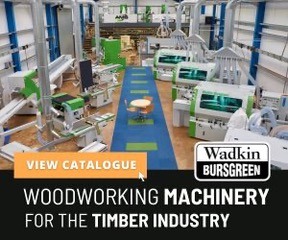Briquetters are a relatively new concept which is quickly becoming a standard item in a typical manufacturing environment.
Among the number of reasons why specifying a briquetter is becoming more popular is the ever-increasing costs of both sending waste to landfill and the cost to provide warmth within the working environment. What previously was seen as wood waste, is widely being recognised as a fuel source for heating the workspace – or even a commodity which could provide an additional income – turning what can be seen as a problem producing waste into a benefit.
The choice of briquetter is just as important as any other machine in the workshop and there is currently an array of machines on the market to choose from, all with different levels of processing and compaction.
However, common to all hydraulically-operated machines is that they work on a given number of cycles per minute and therefore the actual output in kg/h is dependent upon the density/weight of the material being processed.
Therefore, specifications usually give a working parameter of production, for example between 15 and 60kg/h, or may say maximum output 60kg/h. The fact is hardwood is heavier than softwood and given a fixed number of compression cycles per minute will give different levels of production.
The compaction of a briquetter is very important and again some machines offer a higher compaction than others. The reason this is important is that if the briquettes are to be bagged and sold, they must be solid enough to keep their form during packing and transport. Just as important is that the briquette must stay compact when used as a heat source otherwise it will smother the flame instead of burning.
For these reasons, Lacashire-based woodworking machinery specialist, J & C O’Meara, has selected 16 different models to make up its range of briquetting machines which can cater for a huge range of requirements, including the possibility of briquetting MDF dust and having a briquetter directly linked to a dust extraction system, offering a closed circuit from extracting dust to producing briquettes. This also has the benefit of saving labour costs in transferring the waste and also eliminates health and safety risks of manually carrying the large dust bags and the inevitable airborne dust produced during handling.
J & C O’Meara’s series of briquetters are available in three different configurations: Nano – the compact briquetter; Traditional – a series of machines which are gravity-fed, the smallest producing up to 60kg/h and the largest upto 210 kg/h; and Vertical – very similar to the Traditional series, but where the closing cylinder has been mounted in a vertical position, hence changing the shape of the machine to allow easier integration when used directly below a dust unit.
The Vertical machine also has an auger screw to feed the waste, which, coupled with the sensor at the output, will automatically increase/decrease the waste being fed to maintain a consistent size of briquette whilst maximising the efficiency of output. Machines rated to produce from up to 60 kg/h to 220 kg/h.
Carl O’Meara says that he has been selling the company’s Genisis range of briquette machines since 2008 and has a number of successful installations around the country. Along with the traditional joinery machines, the company has been involved with the following projects; a shoe maker, a cardboard recycling company, a shop-fitting a couple of recycling companies and a paper processing company.
• A leather company producing 12 bags of leather dust every day was paying in the region of £1000 every month in landfill costs. After installing a briquette machine, the result was a reduction in waste volume of 70%, resulting in a massive reduction in landfill fees.
• A recycling company with an abundant supply of cardboard shredded and converted this waste into a usable fuel.
• A shopfitting company who processes all types of material including raw MDF linked one of the vertical machines directly to his dust unit and now has free fuel for his wood burning space heater whilst also benefitting in lowered costs in sending waste to landfill.
• A recycling company purchased one of our machines who shreds secure documentation which is then briquetted along with other materials.
• Another installation was where a company was producing a quantity of paper dust along with traditional sawdust. Using an extractor fan to mix the waste which was then blown directly into a briquetter fitted with a filter housing hence there being a closed system.
T 01704 893109
www.ukwoodworkingmachinery.co.uk








